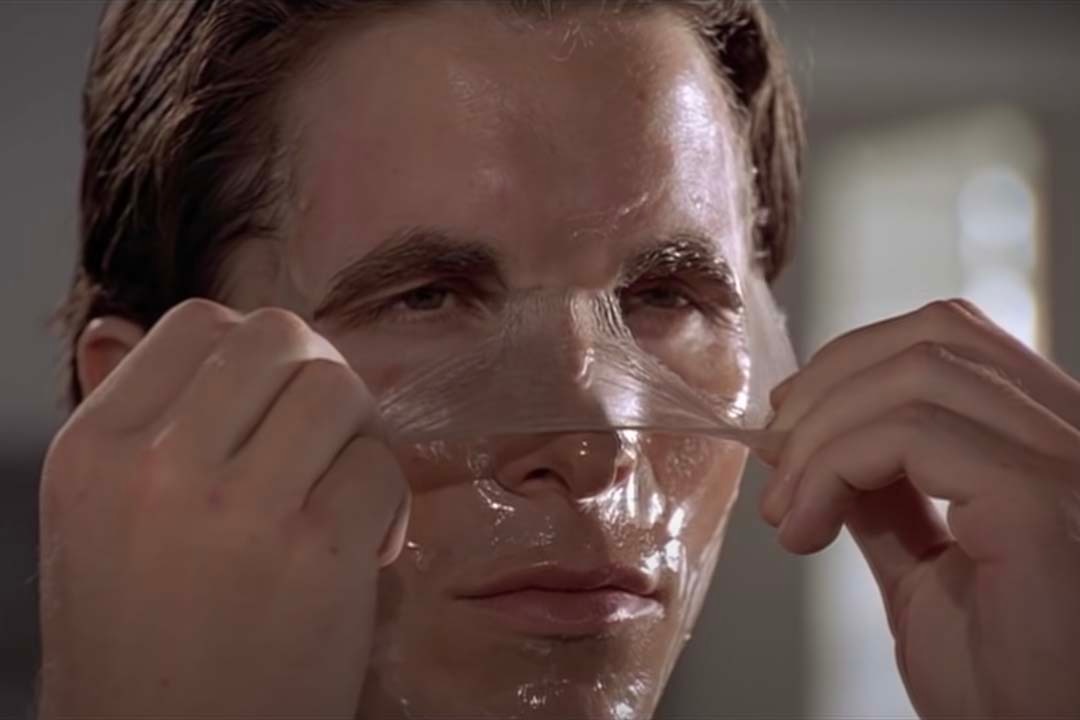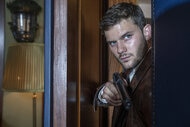Create a free profile to get unlimited access to exclusive videos, sweepstakes, and more!
American Psycho, Now on Peacock, Features What Might Be Christian Bale's Greatest Performance
Let's take a look back at Christian Bale's great work in one of the best horror films of the last 25 years.

It starts with a mask.
That's not the first we see of Christian Bale's Patrick Bateman, the murderous protagonist of Mary Harron's landmark horror-comedy American Pyscho (now streaming on Peacock), but it's the beginning of an understanding that stretches through the rest of the film, in all its excessive, satirical, gruesome glory.
Harron begins her film, an adaptation of Bret Easton Ellis' controversial novel of the same name, with a scene in an upscale restaurant, in which Bateman and his colleagues and friends exist in their natural 1980s yuppie habitat. Moments later, we see the world more from Patrick's sole perspective, as he narrates us through his morning routine of exercises, hygiene, and of course, skincare.
RELATED: Why Women Still Love American Psycho
Released in 2000 to its own brand of controversy, nine years after Ellis' novel hit stores, American Psycho is a richly, often deceptively layered film, designed to make us ultimately question our perception of everything we've seen and who's really suffering in any given situation. With that in mind, we can see Patrick's glimmering, white-walled apartment as its own kind of mask. In a key scene slightly later in the film, Patrick tells his fiancé Evelyn (Reese Witherspoon) that he does what he does because he wants "to fit in," and the apartment is an extension of that desire. Patrick's exceptional habitation, coupled with his traditionally handsome features and body and, of course, his reliance on a bevy of high-cost products to keep him looking his best, is all part of the act, all part of fitting in. This, at least, is a layer of the film we understand instantly.
Then, looking at himself in his bathroom mirror, Patrick puts on a soothing transparent mask, while Bale, through expressiveness that proves he was already one of the best actors of his generation in the years before his superstar turn as Christopher Nolan's Batman, takes his own mask off. Patrick's face seems to lose all of the smirks and snarls that will so animate it for the rest of the film, seems to morph before our eyes into an alien shape as Patrick says "there is no real me." Some of that morphing is thanks, of course, to the glistening texture of the mask itself, but the rest is all Bale, erasing his features in order to prove to us that inside, this man is a roiling cauldron of indefinable hostility without any healthy emotional outlet. He is not a person in the way most of us would consider the word. He is, as he says himself, "simply...not there."
RELATED: Could Christian Bale rise again as Batman? Dark Knight star explains the one way it could happen
It's a bold way to define yourself, as a character and as a narrative, so early in the film, but Harron and Bale do it, and from that point forward we get to see a parade of all the different masks Patrick wears. We see him hire women to make himself look and feel like a prodigious lover, watch him fret over business cards and suits and restaurant reservations as status symbols in his world, even watch him smile and joke his way through social situations as though they're a perfectly natural piece of his life when, in reality, they're all part of a grand play to him. For much of the film, Bale has to play Patrick as a man who's pretending to be an ordinary, soulless yuppie steeped in the world of '80s finance, when in reality he's soulless in an entirely different, more murderous way. Harron and her co-writer, Guinevere Turner (who appears in the film as one of Patrick's victims), make this contrast very apparent through many brutal, hilariously dark scenes, and Bale expertly plays the turns in Patrick's personality.
Except, they might not be turns at all, not in the way that the film originally portrays them, at least. By the end of American Psycho, the film raises the possibility that everything we've seen may have all transpired in Patrick's head, even the more realistic murders and disappearances tied to his behavior. Just how much of the film is imagined brutality and how much is Patrick's privilege letting him get away with certain things is up the the viewer in some ways, but no matter how much of it was real, Bale still had to play all of it. By the third act climax of American Psycho, he's pushing himself to almost cartoonish levels of villainy, and yet he still has to play what Patrick himself believes: That everything he does is a mask, a coping mechanism to deal with a tremendous amount of internal pain. It's a tall order, but he pulls it off, and that's why American Psycho might just be the best performances he's ever given, in one of the best horror films of the last quarter century.
American Psycho is now streaming on Peacock!


























